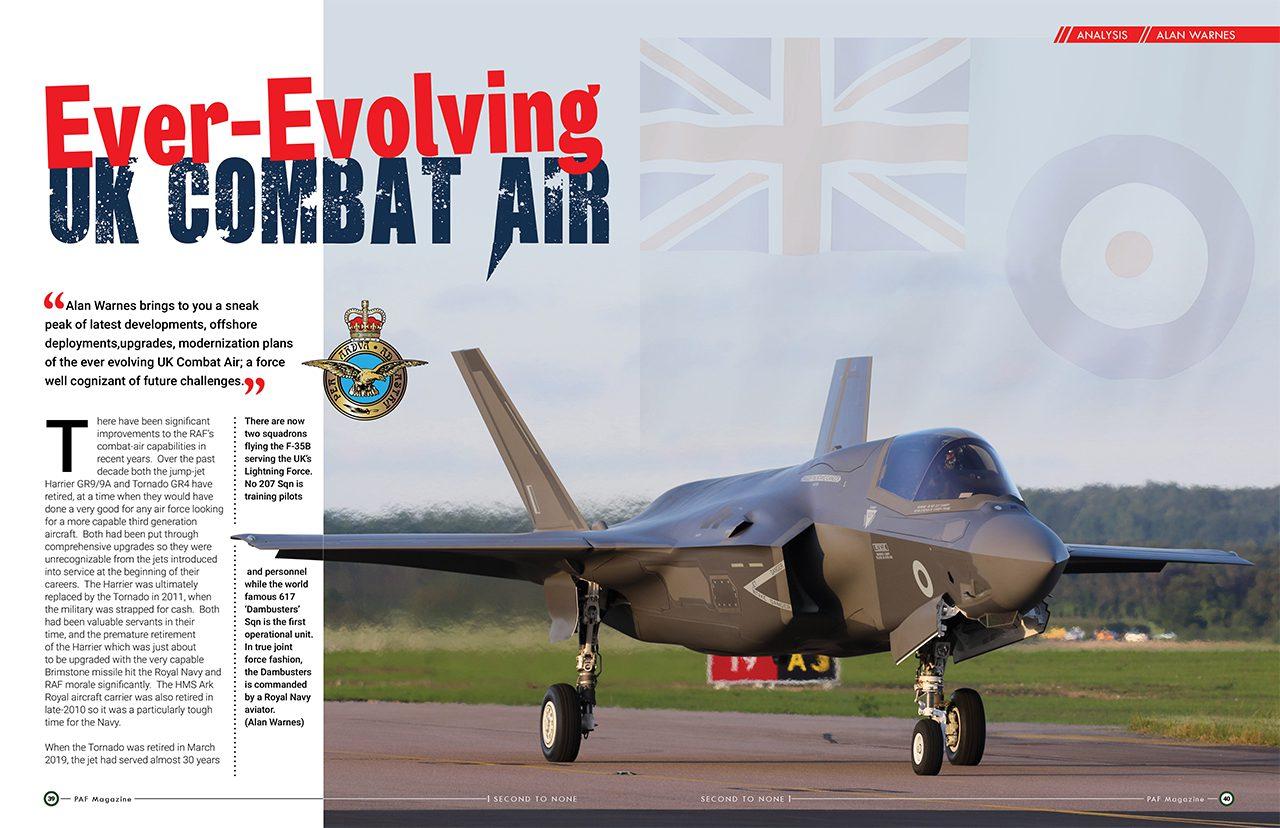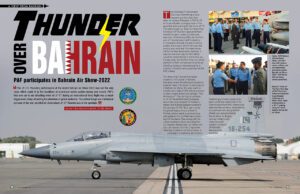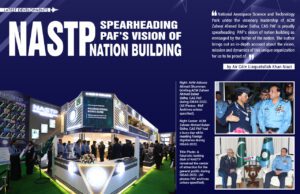Alan Warnes brings to you a sneak peak of latest developments, offshore deployments,upgrades, modernization plans of the ever evolving UK Combat Air; a force well cognizant of future challenges.
There have been significant improvements to the RAF’s combat-air capabilities in recent years. Over the past decade both the jump-jet Harrier GR9/9A and Tornado GR4 have retired, at a time when they would have done a very good for any air force looking for a more capable third generation aircraft. Both had been put through comprehensive upgrades so they were unrecognizable from the jets introduced into service at the beginning of their careers. The Harrier was ultimately replaced by the Tornado in 2011, when the military was strapped for cash. Both had been valuable servants in their time, and the premature retirement of the Harrier which was just about to be upgraded with the very capable Brimstone missile hit the Royal Navy and RAF morale significantly. The HMS Ark Royal aircraft carrier was also retired in late-2010 so it was a particularly tough time for the Navy.
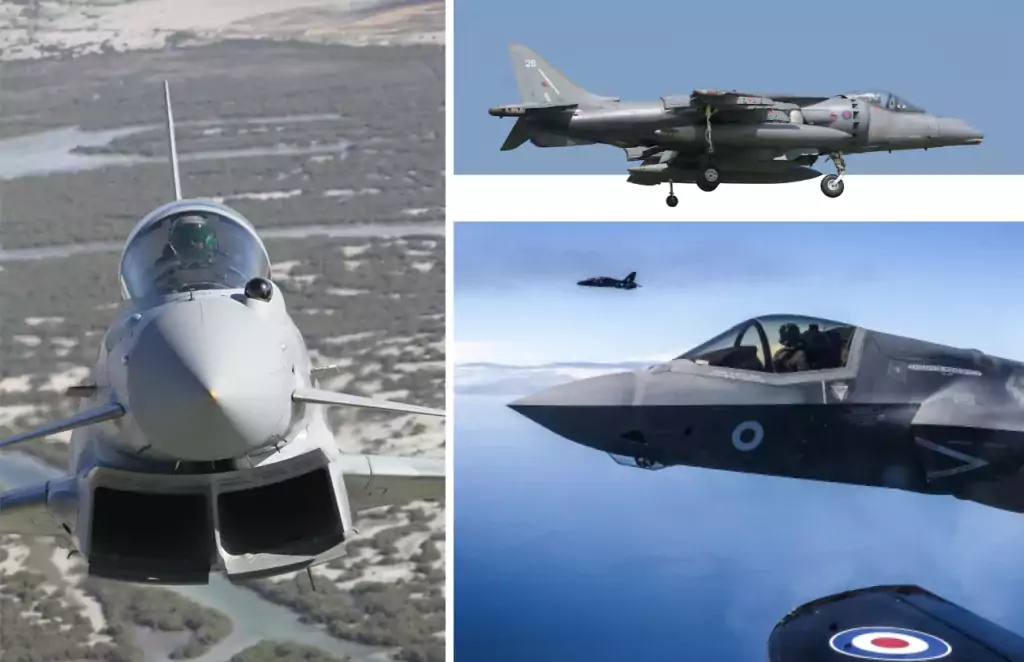
When the Tornado was retired in March 2019, the jet had served almost 30 years of continuous operations. It all started with the Gulf War in 1990, with the ‘Tonka’ ,as they were affectionately called, deploying to the Middle East, and continuing their presence in the region until after Gulf War II when Saddam Hussein was eventually toppled. They moved from the middle east theatre of ops to Kandahar in Afghanistan in 2009, where they replaced the Harriers which had been supporting allied ground troops in the CAS (Close Support) role from 2004. In March 2011, while the Tornado was still in Afghanistan, elements of Tornado GR Force deployed to Gioia del Colle in Italy as part of Operation Ellamy, supporting NATO operations against Colonel Gaddafi. They worked alongside RAF Typhoons until their departure in November 2011. It left Tornados to concentrate their efforts in Afghanistan as part of Operation Herrick until November 2014, but by then Islamic State had taken over huge swathes of Iraq and Syria. It led to the jets being deployed to RAF Akrotiri, Cyprus in August 2014, under the UK’s Operation Shader, providing a much needed reconnaissance capability for the allies and to attack IS targets in Iraq and later Syria.
The Tornados were joined by RAF Typhoons in December 2015, but continued in Cyprus for more than three years before flying their last mission on January 31, 2019 and heading back to RAF Marham, Norfolk on February 4 and retirement in late March. Today the RAF Typhoons are still based at RAF Akrotiri supporting the allies’ efforts against ISIS. Joining the Typhoon on the RAF’s front-line is the F-35B Lightning also known as the Joint Strike Fighter. During June last year they even spent four weeks in Cyprus working up, with some of that time in the air with the Typhoon (see later).
Typhoon
The RAF prides itself on having the best, and right now the Eurofighter Typhoon is undoubtedly a class multirole act following its three-year £425m Project Centurion upgrade Completed in December 2018, allowing Typhoon to replace the Tornado, it now has an extremely flexible capability, with the classy MBDA Brimstone II precision attack missile, MBDA Storm Shadow stand-off weapon and the best Beyond Visual Range Air to Air Missile (BVRAAM), the MBDA Meteor. They all joining the 500Ib Paveway IV laser guided/INS bomb.
A Typhoon used the Brimstone 2 missile for the first time in anger on February 19 last year when it attacked and destroyed a Daesh boat.
Shouldering much of the responsibility for the integration of Project Centurion Typhoons and F-35B Lightnings into service is Air Cdre Dave ‘Bradders’ Bradshaw. He is the Senior Responsible Owner for the RAF’s Combat Air. “I’m charged with keeping the front line fleets up to date with new aircraft, sensors, weapons, avionics and training systems.”
There are currently six squadrons of Typhoons serving the RAF, of which four are responsible for manning the air defence alerts in the UK and in The Falklands. They can be armed with the AIM-132 ASRAAM (Airborne Short Range Air to Air Missile) and the AIM-120C7 AMRAAM (Advanced Medium Range Air to Air Missile). On the weapons fit, the Air Cdre Bradshaw commented: “The weapons suite is dependent upon the operational commander to look at the threat and the demand as to what to actually fly with.”
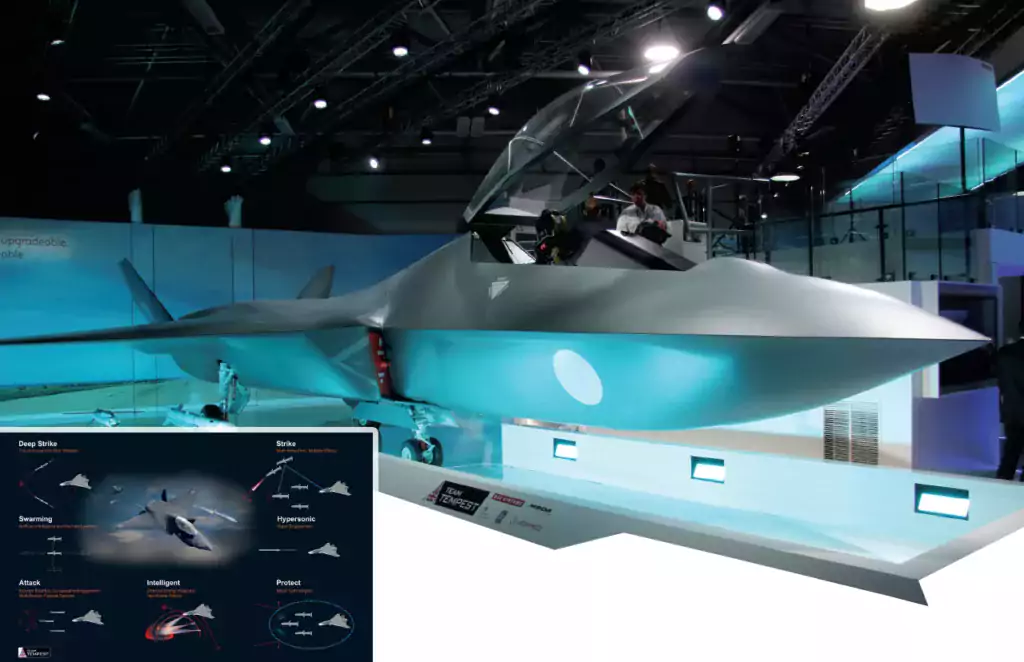
As recently as 29th April Typhoons from RAF Lossiemouth in Scotland scrambled to intercept two Russian Air Force Tu-142 Bear-F long range MPAs. One of the issues with Russian military aircraft these days is they don’t usually communicate ie ‘squawk’ [broadcast an identity code] with air traffic controls, so the Typhoons as well as monitoring the aircraft also assist civilian ATC.
It followed a recent spike in Russian activity close to UK air space. On 12th March six Typhoons intercepted a number of Russian military aircraft operating off the coast of the UK. The previous day, four Typhoons from RAF Lossiemouth intercepted two Russian Tu-142 Bear-F long range MPAs that approached from the north- east and flew in international airspace off the west coast of the UK, down towards the Bay of Biscay, where French assets monitored them and then they returned north. They did not enter UK sovereign airspace. On March 7, six Typhoons intercepted at least two Tu-95 Bears. The QRA at RAF Mount Pleasant, Falkland Islands manned by 1435 Flight, protects UK interests in the South Atlantic. The Typhoon Force has had other recent commitments too, like Baltic Air Policing when XI Squadron Typhoons deployed to Estonia last summer. Over the four-month deployment, known as Operation Azotize, RAF Typhoons conducted a total of 21 interceptions of 56 Russian aircraft in the skies above Estonia. As recently as 28th April No 6 Squadron took four Typhoons to Siauliai, Lithuania for another four-month BAP detachment.
No 1 (F) Squadron from RAF Lossiemouth deployed to Iceland in mid-November last year for a month on the RAF’s first ever Icelandic NATO Air Policing mission. A sixth Typhoon squadron, 12 Sqn was re-established at RAF Coningsby on July 24, 2018 to train Qatari Emiri Air Force (QEAF) personal on the Typhoon. For three weeks in late November/early December last year the squadron participated in Exercise Epic Skies III at Al Udeid, Qatar.
F-35
The Lightning Force is a joint Royal Navy and RAF force. Unlike the RAF/Royal Navy Joint Force Harrier it does not suffer from a tense relationship. To emphasis that, 617 Sqn known as the ‘Dambusters’, arguably the most famous RAF squadron, has a Royal Navy aviator, Commander Mark Sparrow as the commanding officer. The F-35B Lightning reached Initial Operating Capability (IOC) Land status in mid-December 2018. It meant No 617 Squadron could now go to war and the unit lost no time in deploying to Akrotiri, Cyprus with six of its 14 F-35Bs on May 21. As part of a four week work-up exercise, known appropriately as Lightning Dawn, the stealthy jets flew 95 sorties, leading into nine days of combat missions over Iraq and Syria. Between June 16 and June 25, 2019, the six fighters flew 13 combat missions, making the UK the third country, after Israel and the United States to deploy F-35s in a wartime role. They returned home on July 1.
Air Cdre Bradshaw continues: “Our near term focus is to ensure Lightning Force can fight effectively from the Queen Elizabeth carrier and reach Full Operating Capability [FOC] in the 2025 time frame when UK weapons will be integrated.”
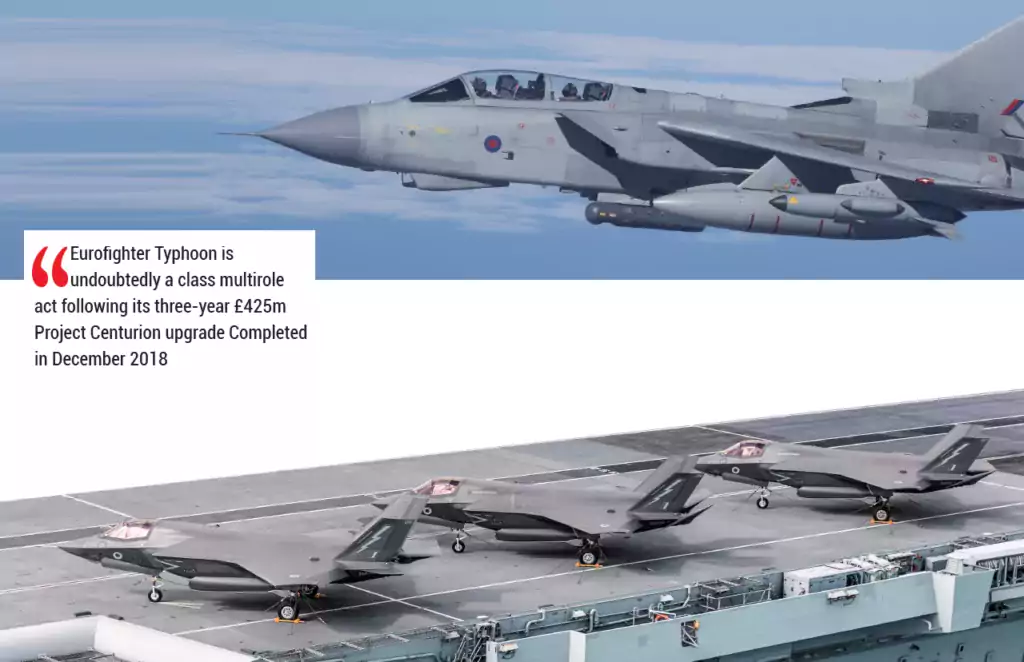
The fifth generation fighter is being prepared for its first operational cruise – known as Carrier Strike Group 21 or CSG21. As part of that work up, No 617 Sqn ‘Dambusters’ participated in Exercise Red Flag in early February. The Air Cdre told the author, “It was the first opportunity to engage the Lightning Force in that high-end training environment. The whole principle of Red Flag is operating together, integrating forces so they can fight in a composite air operations (COMAO) and make sure we can integrate fourth generation with fifth gen platforms like F-15s, F-16s and Typhoons. It is a training exercise, as high end as we could possibly hope for.”
A former RAF Harrier GR7/9 pilot, Air Cdre Bradshaw is now concentrating efforts on the next milestone – IOC (Maritime). “That’s our near term focus ensuring the Lightning Force can fight effectively from the Queen Elizabeth carrier. Which is the main reason 207 Squadron deployed to the carrier around the same time 617 Sqn went to Red Flag.”
No 207 Sqn is the Lightning Operational Conversion Unit, responsible for training pilots for the F-35B Lightning at RAF Marham, Norfolk alongside 617 Sqn. The unit stood up on July 1st last year, under the command of Wg Cdr Scott Williams, who as the Officer Commanding of 207 Sqn took the F-35Bs to the carrier for Exercise Lightning Fury. He has the huge responsibility of growing a sufficiently qualified F-35 force in time for CSG21 for autumn next year. Air Cdre Bradshaw added, “As our F-35B training unit 207 Sqn will qualify its staff, instruct the front line pilots and eventually new ab-initio pilots as they come through the training system.”
Further into the Future
When the UK Combat Air Strategy was published in July 2018, the government set out its ambitions to develop a new fighter system that would be be operational by 2035. Being a critical national asset, important to the security defence of the UK and it wouldn’t just be a military capability, there was a whole layer of UK industry underpinning it with thousands of jobs. The UK hoped to collaborate with international partners, and in 2019 Italy came on board while Sweden has also got involved.
The focus of the Combat Air Strategy is to replace the Eurofighter Typhoon by 2040 and the Team Tempest project group tasked for this sizeable job is made up of BAE Systems, MBDA UK, Leonardo UK and Rolls Royce along with the RAF’s Rapid Capabilities Office.
One of the biggest tasks facing the Tempest team is predicting the sort of systems required for a 2040s-era fighter. Andrew Kennedy, Strategic Campaigns Director, BAE Systems and his team are trying to tether the best of the evidence available to know what is worth investing in. “What we can say is when it comes into service in 2035 we need to make sure the systems on board and off board meet the requirements of all partners.”
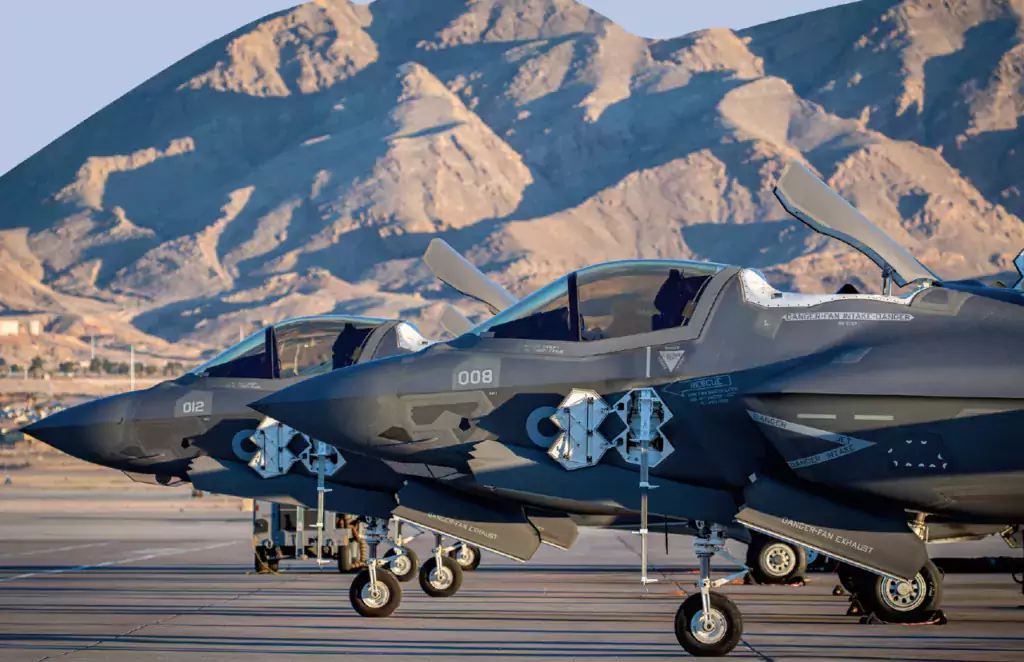
Tempest will be the first time a combat platform, whether manned or un-manned to be designed from the inside out. Leonardo UK is leading work on the Tempest integrated sensors, non-kinetic effects and communications systems, drawing on its expertise in areas such as radar, electronic warfare and electro-optics. The company is carrying out research in a number of areas of complex electronics. “This will sit at the very core of any future platform capability, especially considering the battlespace that Tempest will have to operate within 15 years’ from now which will be more complex, congested and contested than ever before.” Ian Bancroft Director of Major Air Programmes at Leonardo UK told the author in March, then added: “We are working right now with BAE Systems to ensure that space will be available for our sensors. Elsewhere, Rolls Royce is already working on world-leading electrical generation technology for Tempest, recognising that the sensors and effectors, particularly those which are laser-based, will need much more electrical power than previous generations of aircraft. And we’re working closely with MBDA to look at how its effectors can make use of the sensors we’re developing in order to neutralize threats quicker than ever before.”
In the future battlespace, complex electronics will be the key differentiator on-board an aircraft, and will need to accommodate incredibly high-performance sensors and defensive electronic systems. It’s a big challenge!
